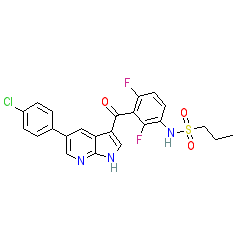GtoPdb is requesting financial support from commercial users. Please see our sustainability page for more information.
|
Synonyms: PLX4032 | RG7204 | Zelboraf®
vemurafenib is an approved drug (FDA (2011), EMA (2012))
Compound class:
Synthetic organic
Comment: Vemurafenib is a Type-2 kinase inhibitor and was first approved by the FDA in 2011.
Ligand Activity Visualisation ChartsThese are box plot that provide a unique visualisation, summarising all the activity data for a ligand taken from ChEMBL and GtoPdb across multiple targets and species. Click on a plot to see the median, interquartile range, low and high data points. A value of zero indicates that no data are available. A separate chart is created for each target, and where possible the algorithm tries to merge ChEMBL and GtoPdb targets by matching them on name and UniProt accession, for each available species. However, please note that inconsistency in naming of targets may lead to data for the same target being reported across multiple charts. ✖
View more information in the IUPHAR Pharmacology Education Project: vemurafenib |
|
|||||||||||||||||||||||||||||||||||
| No information available. |
Summary of Clinical Use  |
| Used in the treatment of unresectable or metastatic melanoma in patients with the BRAF-V600 mutation. In November 2017, the FDA expanded approval to include treatment of Erdheim-Chester disease with BRAF-V600 mutation [1]. |
Mechanism Of Action and Pharmacodynamic Effects  |
| Vemurafenib is a low molecular weight, orally available, inhibitor of BRAF serine-threonine kinase. Activating mutations in the BRAF gene at valine 600 (V600) can cause cell proliferation in the absence of growth factors that would normally be required for proliferation. In biochemical assays vemurafenib can potently inhibit BRAF kinases with a number of these activating V600 mutations. Vemurafenib is notably potent at the BRAF V600E substitution (VAR_018629), a mutation known to activate the mitogen-activated kinase (MAPK) pathway resulting in cell growth, proliferation, and metastasis. Vemurafenib blocks these downstream processes to inhibit tumour growth and eventually trigger apoptosis. Vemurafenib is not known to have antitumour effects in melanoma cell lines expressing wild-type BRAF. |
External links  |
|
For extended ADME data see the following: Electronic Medicines Compendium (eMC) Drugs.com European Medicines Agency (EMA) |









